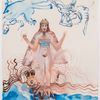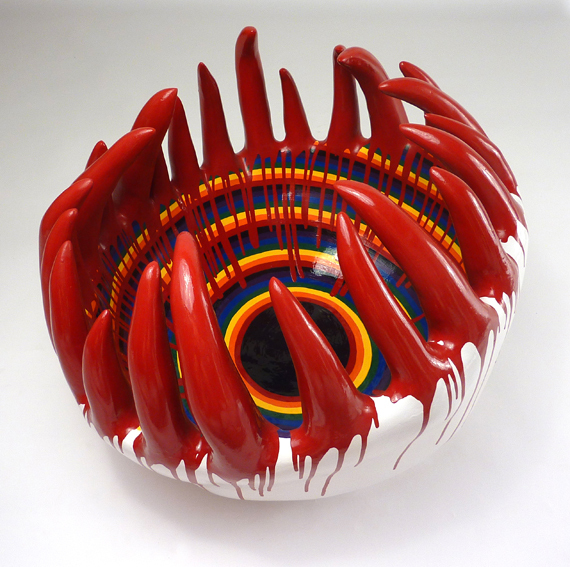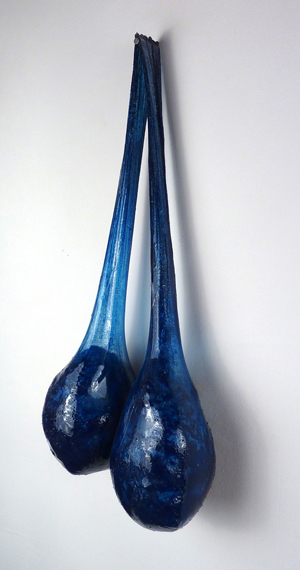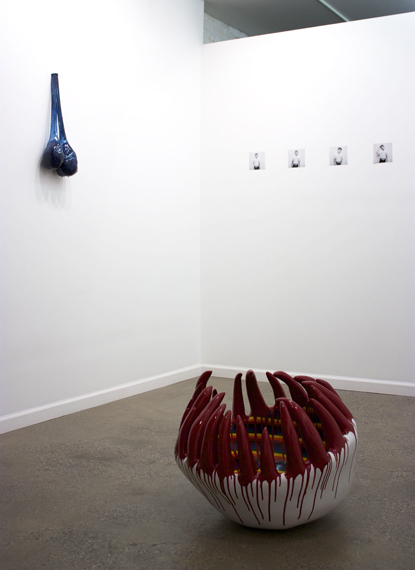Rainbow Eye Claw, acrylic, Aqua-Resin, armature wire, chicken wire, hydrocal, newspaper, oil enamel, and plaster, 27"L x 25"W x 20"H, 2014, Courtesy of the Artist
Liz Insogna: I've been drawn to your Rainbow Eye Claw since meeting it in the beginning stages at your studio, unvarnished and white, so many months ago. Seeing it again recently, in the summer exhibit at Munch Gallery, highly charged with color and weighted with the gravitational pull of vision downward and into; I'd love to hear about your relationship to it and this process.
Hein Koh: That piece was a real breakthrough for me. It was the first time I made a sculpture in a hard material (i.e. plaster, hydrocal and Aqua-Resin, which is a powdered resin) as opposed to the soft, fabric sculptures I had made before. I've only been making sculptures for three years now, switching from painting, and this was the first time I really delved into using plaster and hydrocal, which eventually led me to the more durable Aqua-Resin because my sculptures kept breaking. So, the making of Rainbow Eye Claw was a long, arduous process because I was learning how to use a lot of different materials through the making of the piece, which is also why it ended up being so heavy.
On a deeper level, my relationship to the piece is very psychological, but I like to keep it vague and open, even in my own head. I work in a stream-of-consciousness manner, drawing from my psyche and letting it manifest itself through my work. This piece, like many others, started off as imagery that popped up in my mind, that I felt compelled to sketch and turn into a sculpture. The decision to paint it the way I did happened very intuitively and organically; every decision just felt "right." I don't like to think too hard about why I make what I make; rather, I try to follow strong impulses and compulsions and perhaps later on, after I've made a number of pieces, I'll reflect on the meaning of my work. I don't think it's that important to completely understand what you do -- I think there is value in leaving things open, unknown and mysterious.
Blue Balls, acrylic, EnviroTex, pantyhose, polyfil, rocks, 22.5"L x 8.5"W x 4.5"D, 2013, Courtesy of the Artist
LI: Your process seems both natural and realistic in that you and it are going somewhere together, and accept that you don't know what it will look like until you get there. Accepting that mystery is inherent in creating work and living with it. It's an intense piece and I have to say that I love the element of humor that Blue Balls evokes, hanging nearby. In what ways might the works relate to each other for you in the exhibit and/or outside of it.
HK: Beyond the colors complementing one other, I hadn't thought much about their relationship to each other before the show, especially since I had finished Blue Balls a year before Rainbow Eye Claw. However, at the opening, a friend of mine talked about Blue Balls being male and Rainbow Eye Claw being female, enjoying the relationship between the two. Blue Balls is obviously gendered, but I hadn't thought of Rainbow Eye Claw as "female" although I could see how the rounded, vesseled qualities of it could render it feminine, like a womb or vagina. While a lot of my work has obvious feminine imagery, I thought I was starting to move away from it with Rainbow Eye Claw, but it looks like it's still being read in the work. In that case, I like the idea of the female being the aggressor, with bloody claws, while the male is in a compromised position having "blue balls." Sexuality and gender are important themes in my work, and I'm interested in how power dynamics play through them. Humor also comes up in my work, these days in a much more subtle way than in the past, but I still think it's important to approach life with a sense of lightness. One can take issues very seriously but still have a sense of humor about them; it need not be mutually exclusive.
LI: I love your narration into the works as well as your relationship to them. On thinking further about this process, working intuitively with the work, the concept of ideomotion or the ideomotor effect comes to mind. This takes into account the unconscious motions that respond in the moment without us being aware -- it's been used to try to understand the nature of automatic writing and ouija boards, although in reality the mystery of it is much larger than what is known. In the light of this could you go a little deeper and talk more about your experience with your relationship to the work and the qualities of sexuality, gender, and power dynamics that come up with it?
HK: Through my work, I've come to realize how important issues of gender and sexuality are to me, and how they much they shape us, our perspectives and our perceptions of each other. I'm interested in what defines masculinity and femininity, subverting stereotypes, and the idea of gender as construct. It's very political for me too, because I'm against the idea of pigeonholing people into neat categories; I believe we should accept the inherent complexity of people. People typically categorize and stereotype all the time; upon meeting someone, one may try to figure out gender, sexual orientation, race, etc. and even ask the questions aloud. There's nothing wrong with being curious, but you have to ask yourself what your motivations are. Why do you need to know these things? A lot of the time, it's because you want to draw a conclusion based on a "fact" about the person, when really, there's no correlation - the purported "fact" is not objective, it's subjective and nuanced. I prefer basing my relationships with people on the idea that these supposed facts are fluid and changeable; instead of basing them on some kind of perceived fixed identity, they are based on the general core of a person's soul. Whatever questions we have about each other are answered in time, organically, as we get to know one other. That's what it means to really connect with someone and let the relationship unfold, as people and not as a bunch of labels.
Categorizing is typically how people try to make sense of the world, but I think it's a very limiting perspective. In that way, I think of my work as a utopian language, where dualities can co-exist and boundaries are blurred. I know I haven't fully addressed your question, but in light of the idea of "ideomotion," this is the response that came up so I'm going to go with it since it's important to me.
Installation photo, Munch Gallery, (the photographs on the wall are by Amos Mac) c. Hein Koh
Born in Jersey City, NJ, Hein Koh is an artist based in Brooklyn, NY. She holds two BAs from Dartmouth College, in studio art and psychology, and received her MFA in Painting/Printmaking from Yale. She is a recipient of a Mid-Atlantic Arts Foundation Grant, and an alum of the Artists in the Marketplace program at the Bronx Museum of the Arts, which culminated in a catalogued museum exhibition in 2011. Her work has been reviewed and/or featured in The New York Times, The Philadelphia Inquirer, The Brooklyn Rail, and The Huffington Post. She has also taught and/or lectured at Tyler School of Art, Dartmouth College, Maryland Institute College of Art, and the School of Visual Arts.
Summer exhibition with Hein Koh's work on view through August 10th, 2014 at the summer exhibition at Munch Gallery with Erik Foss, Scooter LaForge and Amos Mac. For details visit here.
Hein Koh is an artist in Brooklyn.
Liz Insogna is a painter in Brooklyn.



